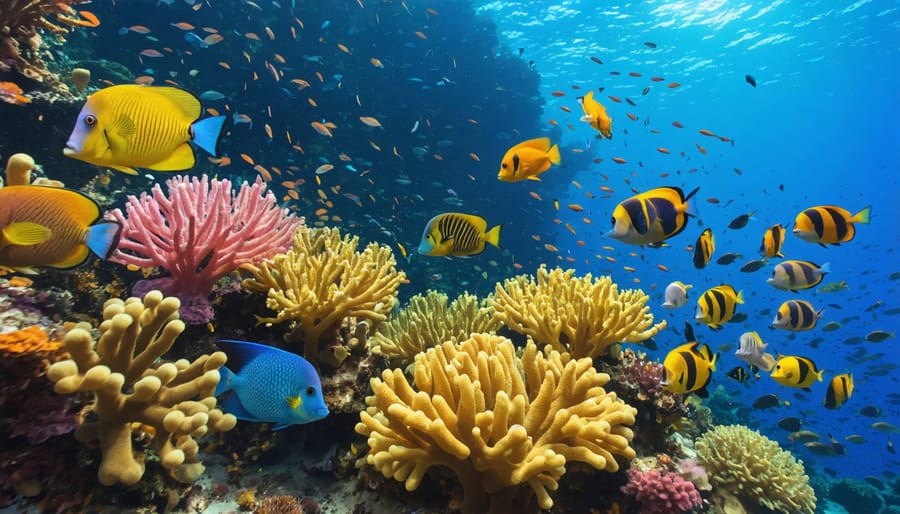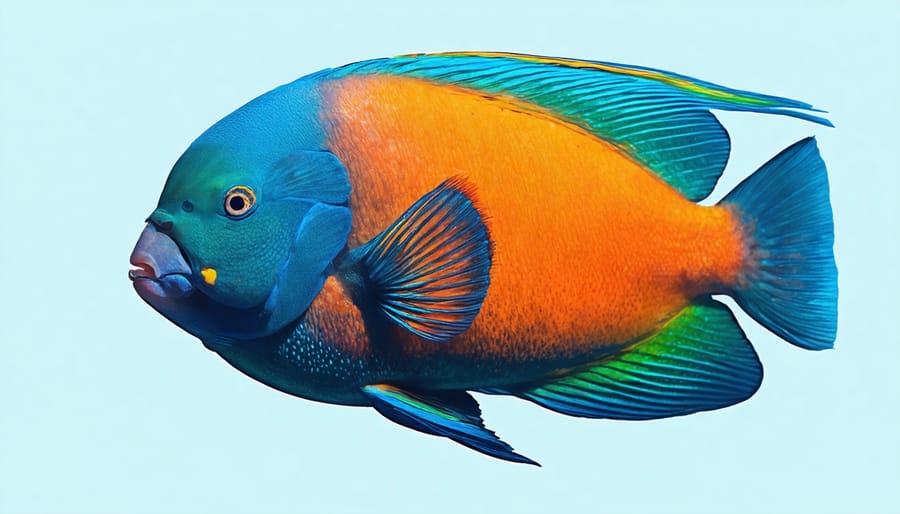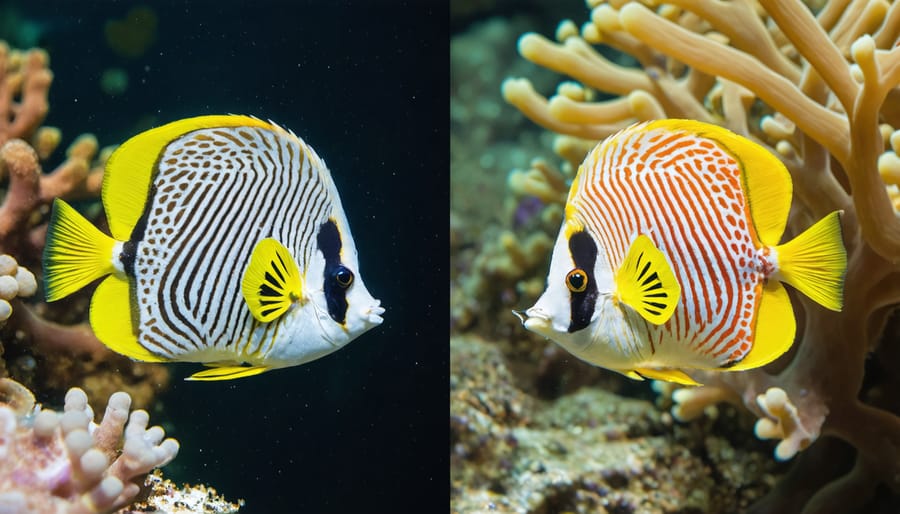
In the vibrant underwater world of coral reefs, herbivorous fish serve as crucial ecosystem engineers, maintaining the delicate balance between corals and algae through their grazing behaviors. These remarkable creatures, from tiny damselfish to massive parrotfish, rely heavily on visual communication in marine environments to coordinate their activities, avoid predators, and establish social hierarchies. Their intricate visual signals – including dramatic color changes, distinct body patterns, and synchronized swimming behaviors – represent one of nature’s most sophisticated communication systems. As coral reefs face unprecedented threats from climate change and ocean acidification, understanding the role of these herbivores becomes increasingly vital for marine conservation efforts. Their feeding activities not only prevent algal overgrowth that could smother corals but also create space for new coral recruitment, making them indispensable architects of reef resilience. Through studying these remarkable creatures, scientists are uncovering new insights into the complex relationships that sustain coral reef ecosystems and developing more effective strategies for their preservation.
The Visual World of Coral Reef Herbivores
Color Vision in Reef Fish
Reef herbivores possess remarkable color vision capabilities that help them navigate their vibrant coral reef environment. Unlike many other fish species, these herbivores can distinguish between subtle variations in color, which is crucial for identifying edible algae and avoiding toxic varieties. Their visual system includes specialized cone cells that are particularly sensitive to blue and green wavelengths, reflecting their adaptation to the underwater light spectrum.
Research has shown that many reef herbivores can see ultraviolet (UV) light, an ability that aids in recognizing nutritious algae patches and detecting potential predators. This enhanced color perception also plays a vital role in social interactions, allowing fish to recognize members of their own species and potential mates through distinct color patterns.
The quality of light changes dramatically with depth in coral reef environments, and reef herbivores have evolved to compensate for these variations. Their eyes contain pigments that adjust to different light conditions, enabling them to maintain effective color vision even in deeper waters where certain wavelengths of light are filtered out by the water column. This adaptation ensures they can continue grazing and protecting reef ecosystems across various depths and lighting conditions.

Environmental Factors Affecting Visual Signals
Visual communication among coral reef herbivores is significantly influenced by the dynamic underwater environment they inhabit. Light penetration through water decreases exponentially with depth, creating distinct zones where different wavelengths of light are filtered out. This filtering process affects how fish perceive colors and shapes, particularly impacting their ability to recognize visual signals from conspecifics.
Water clarity plays a crucial role in visual communication effectiveness. Turbidity, caused by suspended particles or plankton blooms, can severely reduce visibility and alter underwater light patterns. In clearer waters, visual signals can travel further, allowing herbivorous fish to maintain social connections across greater distances.
Depth also significantly impacts visual communication. As herbivorous fish move between different depth zones, they must adapt their visual signaling behaviors. Shallow-water species often display more vibrant colors and complex patterns, while deeper-dwelling herbivores may rely more on contrast and movement-based signals. This adaptation helps ensure effective communication despite varying light conditions throughout the water column.
These environmental factors have led to the evolution of sophisticated visual communication strategies among reef herbivores, demonstrating their remarkable ability to adapt to their dynamic marine environment.
Visual Signals for Social Communication
Territorial Displays
Coral reef herbivores employ sophisticated marine visual signals to establish and defend their feeding territories. These displays are crucial for survival, as quality grazing areas are limited and highly contested resources on the reef. Species like parrotfish and surgeonfish demonstrate remarkable color-changing abilities, shifting from their normal hues to more intense patterns when confronting territorial rivals.
During territorial disputes, herbivorous fish employ a series of escalating displays. Initial warnings often involve lateral displays, where fish turn sideways to appear larger to potential competitors. If this fails to deter intruders, they may intensify their display by erecting their fins, changing colors, and performing aggressive swimming patterns. For instance, stoplight parrotfish males can rapidly switch from their usual greenish color to a striking white-and-red pattern when defending their territory.
These visual demonstrations serve multiple purposes: they help avoid costly physical confrontations, establish social hierarchies, and ensure efficient resource distribution among reef herbivores. The complexity of these displays varies among species, with some maintaining year-round territories while others defend temporary feeding areas during specific seasons.
Remarkably, these territorial behaviors also contribute to reef health by preventing overgrazing in specific areas and promoting even distribution of herbivory across the reef ecosystem. Understanding these patterns helps marine biologists develop more effective conservation strategies for maintaining healthy reef communities.

Mating Signals
Coral reef herbivores employ fascinating visual signals during their mating rituals, which are crucial for species recognition and reproductive success. Many species undergo dramatic color changes during breeding seasons, with males often displaying the most vibrant transformations. For instance, male parrotfish develop distinct breeding colors, sometimes shifting from dull browns to brilliant blues and greens within hours.
Physical displays also play a vital role in courtship. Male surgeonfish perform elaborate swimming patterns, including rapid circles and figure-eight movements, to attract potential mates. These displays not only demonstrate their fitness but also establish territorial boundaries during breeding periods.
Size dimorphism is another important visual cue, with males of many species growing larger than females. This difference is particularly noticeable in rabbitfish, where males develop more elongated fins during breeding season. Some species also exhibit temporary markings or patterns that appear only during courtship, serving as clear signals of reproductive readiness.
Timing is crucial for these visual displays, with many species synchronizing their color changes and courtship behaviors with lunar cycles or seasonal changes in water temperature. This synchronization ensures that potential mates can recognize and respond to these signals effectively, maximizing reproductive success.
Scientists have observed that environmental stressors, such as water quality changes and habitat degradation, can affect these visual mating signals, potentially impacting reproduction rates and population stability.
Predator-Prey Interactions

Camouflage Strategies
Coral reef herbivores employ various sophisticated camouflage strategies to survive in their vibrant but dangerous environment. Many species have evolved remarkable abilities to change their coloration and patterns to match their surroundings, offering protection from predators while they graze on algae.
Parrotfish, for instance, demonstrate some of the most advanced color-changing abilities among reef herbivores. During different life stages and daily activities, they can shift their appearance from bright, conspicuous colors to more subdued tones that blend with coral and rock formations. At night, many species secrete a mucus cocoon that not only helps them hide but also protects them from predators.
Surgeonfish utilize countershading, where their dorsal side is darker than their ventral side, making them less visible to both predators above and below. This adaptation is particularly effective when combined with their ability to adjust their overall brightness to match the ambient light conditions.
Some herbivorous fish, like rabbitfish, possess disruptive coloration patterns that break up their body outline, making them harder to detect among coral branches. Juvenile tangs often display patterns that mimic dead coral leaves, allowing them to feed safely in shallow waters.
These camouflage strategies are not just passive defenses. Many species actively select feeding locations that complement their coloration, demonstrating the sophisticated integration of behavior and physical adaptation in coral reef ecosystems.
Warning Signals
Many coral reef herbivores employ a fascinating defense strategy known as aposematism, using vibrant colors and patterns to signal their toxicity or unpalatability to potential predators. This natural warning system, similar to other light-based defense mechanisms in marine environments, has evolved over millions of years.
Parrotfish, for example, display stunning blues, greens, and pinks that serve as a clear message to predators about their tough scales and unpalatable flesh. The butterflyfish family showcases eye-spots and bold stripe patterns, warning would-be attackers of their sharp spines and toxic mucus coating. Even some species of surgeonfish use their distinctive color patterns to advertise their razor-sharp tail spines.
These warning signals are particularly effective because predators learn to associate certain color patterns with negative experiences. Marine biologists have observed that young predatory fish quickly learn to avoid prey with specific warning coloration after just a few encounters. This learned behavior helps maintain the effectiveness of these visual deterrents across generations.
Interestingly, some coral reef herbivores change their warning colors as they mature or during different times of the day. This dynamic color-changing ability not only serves as a defense mechanism but also plays a role in social interactions and territorial displays within their species.
Conservation Implications
Threats to Visual Communication
Water quality degradation poses significant challenges to visual communication among coral reef herbivores. As coastal development, agricultural runoff, and climate change increase water turbidity, the clarity essential for visual signals becomes compromised. Suspended sediments and algal blooms scatter light and reduce visibility, making it harder for fish to recognize potential mates, identify territorial boundaries, or spot approaching predators.
Habitat loss further compounds these challenges. When coral reefs degrade or die, the complex three-dimensional structure that provides important visual reference points disappears. This loss affects how herbivorous fish navigate their environment and maintain social hierarchies through visual cues. For example, parrotfish rely on specific coral formations as landmarks during courtship displays, while surgeonfish use distinct reef features to mark feeding territories.
Marine biologists have observed changes in fish behavior where water quality is poor, with some species showing reduced courtship displays or altered feeding patterns. This disruption of visual communication can lead to decreased reproductive success and altered social structures within reef communities, potentially affecting the long-term survival of these crucial herbivore populations.
Protection Strategies
Understanding visual signals in coral reef herbivores has led to innovative protection strategies that enhance conservation efforts. Marine protected areas (MPAs) are now being designed with consideration for the visual communication needs of these crucial species. For instance, preserving clear-water zones where fish can effectively display their warning colors and social signals has become a priority in conservation planning.
Researchers are using this knowledge to develop more effective artificial reef structures that incorporate specific colors and patterns known to attract herbivorous fish. These structures serve as vital stepping stones between fragmented reef systems, helping maintain connected populations.
Conservation teams are also implementing light pollution reduction programs in coastal areas, as artificial lighting can disrupt the visual signals these species rely on. Educational programs now emphasize the importance of maintaining water clarity and reducing sedimentation, which directly impacts the effectiveness of visual communication among reef herbivores.
Citizen science projects invite divers and snorkelers to document fish behavior and coloration patterns, contributing valuable data to conservation efforts. This participatory approach has improved our understanding of how these species use visual signals while fostering public engagement in reef protection.
Visual signaling among coral reef herbivores represents a crucial aspect of reef ecosystem health and stability. These intricate communication systems, developed over millions of years of evolution, enable herbivorous fish and other marine creatures to maintain social structures, defend territories, and coordinate grazing patterns that keep coral reefs healthy and resilient.
As our oceans face unprecedented challenges from climate change, pollution, and habitat destruction, understanding and protecting these communication networks becomes increasingly vital. The complex visual signals used by parrotfish, surgeonfish, and other herbivores don’t just facilitate their survival – they contribute to the broader ecosystem services that maintain reef health through controlled algal growth and biodiversity maintenance.
The preservation of these remarkable species and their habitats requires immediate action from the global community. Marine protected areas, responsible tourism practices, and reduction of local stressors can help maintain the environmental conditions necessary for these visual communication systems to function effectively. Everyone can contribute to this effort, whether through supporting marine conservation organizations, participating in citizen science projects, or making sustainable choices in daily life.
By protecting coral reef herbivores and their habitats, we safeguard not just these fascinating communication systems, but the future of coral reefs themselves. The time to act is now, and every effort counts in preserving these underwater gardens for future generations to study, admire, and protect.
jessica
Ava Singh is an environmental writer and marine sustainability advocate with a deep commitment to protecting the world's oceans and coastal communities. With a background in environmental policy and a passion for storytelling, Ava brings complex topics to life through clear, engaging content that educates and empowers readers. At the Marine Biodiversity & Sustainability Learning Center, Ava focuses on sharing impactful stories about community engagement, policy innovations, and conservation strategies. Her writing bridges the gap between science and the public, encouraging people to take part in preserving marine biodiversity. When she’s not writing, Ava collaborates with local initiatives to promote eco-conscious living and sustainable development, ensuring her work makes a difference both on the page and in the real world.
